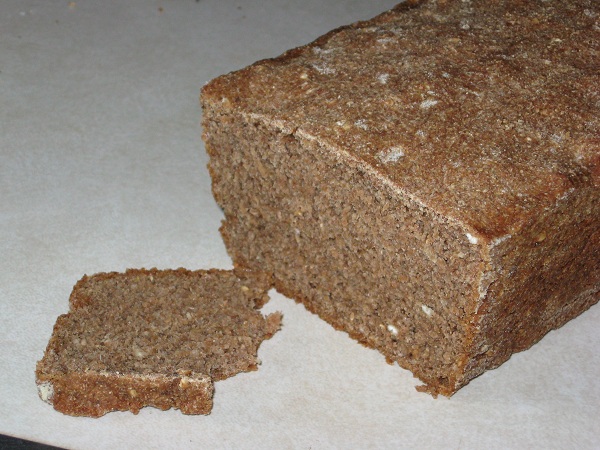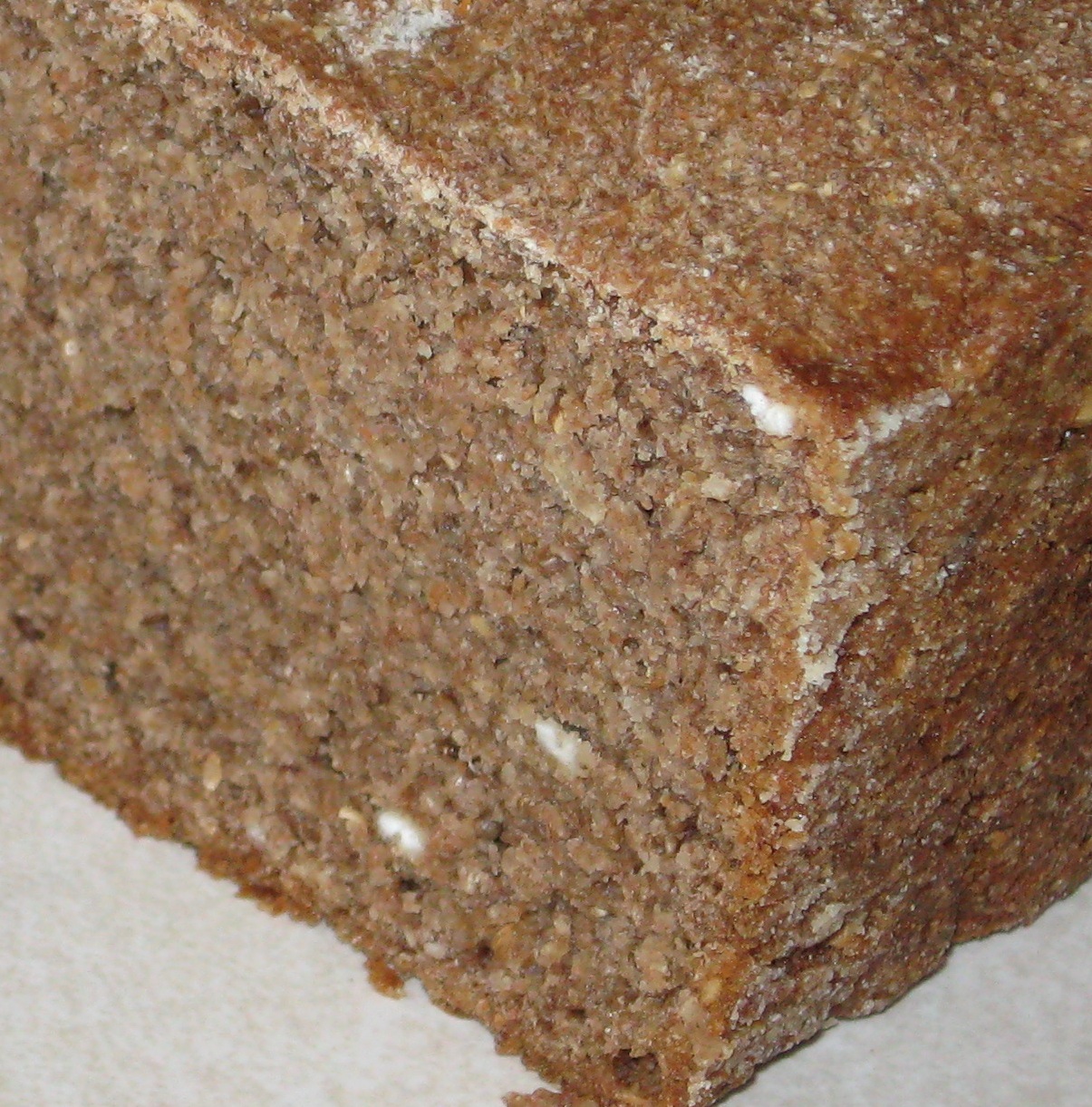Last night I planned to use the discard from my new rye sourdough starter in a test loaf this morning. The starter is past the quiet part of its development and is bubbling vigorously, although it is still quite young. My plan was to treat the project as if it was wheat sourdough, with the understanding that the bread would not rise as much, or maybe not at all if I made too many mistakes. My plans fell apart when I found myself standing at late evening in a very hot kitchen with the ice cream maker running for the second time after noon, some dried beans hot from the oven needing sifting to remove the bean weevils that had been killed by the heat, the sink full of dishes, and this bread project still needing attention. I just threw everything I had ready for the bread into one bowl overnight, in the refrigerator.
In the morning I added some more materials, some measured and some not. The bread that I baked from that is actually edible, to my surprise. The loaf is not rock hard. The slices are pliable. They can be eaten without crumbling. They can be paired around cheese for a sandwich. I made the bread a little too sweet for my taste, but otherwise it is seems good. The only problem I have with it is that the "after-feel" is slightly mucilaginous. Don't get me wrong. The crumb is not slimy, or wet, or gummy to the hand or when chewing. There is just this feeling after eating the bread, almost of a light coating on the tongue. What could this be due to?
Pictures and recipe follows, at least so far as I know the recipe. The white splotches are the flaked grain, which turned out to be stupidly sparse inside the loaf. It should have gone on top of the loaf before baking, as a topping, but as I said I was not thinking very clearly last evening. I just wanted it out of the way so I could deal with everything else and get out of the hot kitchen.


Prefermented overnight in refrigerator:
- 12 ounces active rye starter produced with whole rye milled to medium meal, batter consistency (200% hydration?)
- 1 Tbls whole barley, flaked
- 1 Tbls whole oats, flaked
- 1 Tbls whole coriander, crushed
- 1/2 cup rye grain, milled to flour - weight unknown but the resulting mixture was dry, maybe about 45% hydration or slightly less
Morning additions:
- 1 tsp salt
- 2 Tbls dark brown sugar
- 8 oz rye grain, milled to flour
- "some" kefir whey
After 5 minutes of mixing with a dough hook, this seemed far too wet. I added another 4 oz of rye grain, milled to the fine meal/coarse flour level just for variety. Another 10 minutes of mixing with a dough hook yielded a lump that could with care be moved into a bowl oiled with 1 tsp olive oil.
I let this rise for 1 hour, then went to see whether a stretch and fold was possible. To my surprise, it had actually risen although "stretch and fold" was more like "press out and fold" because the dough had no elasticity or extensibility. Remembering that most recipes said 100% rye bread would not tolerate overly long rises, I packed the folded dough into a greased 8x4 loaf pan and left it to rise again.
One hour later it had risen about 1/2" in the pan. There were still bubbles coming out. I could tell because I used a pan grease that is liquid in hot weather, and it was bubbling in one spot. I preheated the oven and placed the loaf pan inside, under an inverted stainless steel bowl to trap steam. After baking for 20 minutes as 425 F, I took away the bowl. There had been little or no oven spring. I baked it for another 40 minutes at 325 F. I don't know the final temperature because we were eating dinner and I missed hearing the oven beep when the baking was done. I removed the pan from the oven some time later, after the oven had already mostly cooled down. I turned the loaf out to finish cooling. I remembered what had been said about rye bread needing to be wrapped in foil and left for 24 hours in order to cut properly, but I decided to try it anyway once it was cool. It cut fine.
Hi MangoChutney, I could add a few recipes to the Journal of Irreproducable Baking.
Creating a tasty loaf that way (while clearing the fridge of old starters) - that feeling of archievement without using a safety net...
It's literally my daily bread. There's no need to mix so much as rye doesn't develop any gluten. It's sufficient to blend ingredients until the dough is homogeneous. 10 minutes are an eternity, also because rye doughs tend to liquify.
I guess that the "mucilaginous"effect you feel in your mouth is due to the gelly nature of the rye dough (if you knead by hand with wet hands -as you always should with rye- you will have the same feeling).
Ah, thank you. I wondered if it was a natural property of rye. My husband said he didn't get that feel from it, but then again he also said it didn't taste sweet to him. Since he had just eaten a handful of chocolate chips I am not sure what his opinion was worth except that he did not think the bread was bad, which is very important to me.